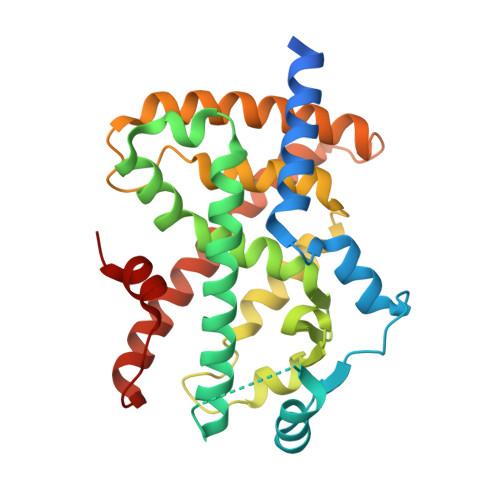Structures of PPAR gamma complexed with lobeglitazone and pioglitazone reveal key determinants for the recognition of antidiabetic drugs
Lee, M.A., Tan, L., Yang, H., Im, Y.G., Im, Y.J.(2017) Sci Rep 7: 16837-16837
- PubMed: 29203903
- DOI: https://doi.org/10.1038/s41598-017-17082-x
- Primary Citation of Related Structures:
5Y2O, 5Y2T - PubMed Abstract:
Peroxisome proliferator-activator receptor (PPAR) γ is a nuclear hormone receptor that regulates glucose homeostasis, lipid metabolism, and adipocyte function. PPARγ is a target for thiazolidinedione (TZD) class of drugs which are widely used for the treatment of type 2 diabetes. Recently, lobeglitazone was developed as a highly effective TZD with reduced side effects by Chong Kun Dang Pharmaceuticals. To identify the structural determinants for the high potency of lobeglitazone as a PPARγ agonist, we determined the crystal structures of the PPARγ ligand binding domain (LBD) in complex with lobeglitazone and pioglitazone at 1.7 and 1.8 Å resolutions, respectively. Comparison of ligand-bound PPARγ structures revealed that the binding modes of TZDs are well conserved. The TZD head group forms hydrogen bonds with the polar residues in the AF-2 pocket and helix 12, stabilizing the active conformation of the LBD. The unique p-methoxyphenoxy group of lobeglitazone makes additional hydrophobic contacts with the Ω-pocket. Docking analysis using the structures of TZD-bound PPARγ suggested that lobeglitazone displays 12 times higher affinity to PPARγ compared to rosiglitazone and pioglitazone. This structural difference correlates with the enhanced affinity and the low effective dose of lobeglitazone compared to the other TZDs.
Organizational Affiliation:
College of Pharmacy, Chonnam National University, Gwangju, 61186, Republic of Korea.















